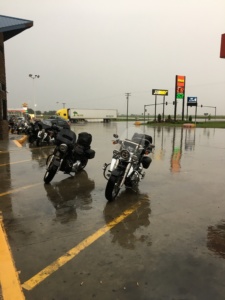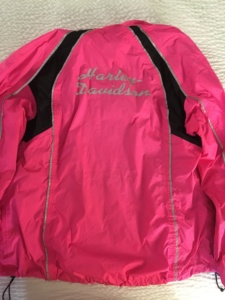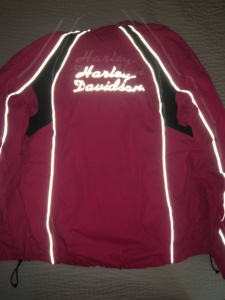Part 1–
Cruising on a bike isn’t necessarily rolling through the Sonic Drive-In on a warm Saturday night. But it is nice to roll your bike out on a decent day, take a spin and return home that night. That’s what the class of “Cruiser” bikes were best designed to do. They are great for fair weather riding close to home.

Touring , on the other hand, generally involves overnight travel, sometimes long distances and many nights. This means riding in weather. Rain, wind, cold, whatever gets dished out, you have to learn to equip yourself and deal with it.
I started riding Cruisers and then switched to Touring after my initial training with the Women’s Freedom Ride. I learned to not fear weather. That doesn’t mean I like it, I just don’t fear it. It doesn’t prevent me from riding.
So, I’m in Deadwood, SD on vacation. The weather is heavy rain, with more forecast. I’m in the covered parking garage, getting ready to ride. A couple was loading luggage in their car nearby.
The guy turned to me and asked, “Are you one of those one-day riders?” I didn’t know what that meant, so I asked what that was.
He replied, “You know, someone who brings their bike to the Sturgis Rally, rides it once, then puts it away”. I laughed and told him that I was nothing of the sort. I’m an all-weather, year round rider.
He said that was good, but was I aware that it was raining outside? I laughed even more and motioned to my coat and said, “This is called a rain suit. It’s what you wear in the rain”. 🙂
He told me the weather was going to get bad. By now, I’m becoming a little impatient, like some guy is telling this little girl she shouldn’t be doing this.
I finally, said, “Listen, I’m not posing as a biker. I’m a very serious real biker. I ride in the rain, I ride in the cold, I ride in the wind. I rode 3,000 miles from Lincoln, Nebraska to Las Vegas and back in the cold of November. The temp when I left home was 24 degrees, with winds out of the north at 25 to 40 mph. I’ve ridden all day in driving rain at 80 mph, in formation with 30 other women bikers”. (Women’s Freedom Ride 2017, thank you)
He realized he’d been put in his place. He was in a car. He shouldn’t be giving advice to a woman who was actually riding a motorcycle.
He became very supportive, expressed admiration and told me to ride safe.
Part 2–
So, let’s talk about riding in the rain. You first need good rain gear for touring travel. For cruising, tarp from Bob’s Closeouts might do, but this is serious stuff. 🙂
If you can find a bright color, that’s a real plus. I was told I could be easily seen from a quarter mile away in this jacket. It’s real Harley Davidson gear. Some will bash Harley stuff for being expensive, which it is, but I’ve found it to be extremely well designed and built. It’s great value for the money. If you’re 500 miles from home and you get cold and wet, saving a few bucks doesn’t seem like such a great deal.
 Before buying any riding gear, take a photo like this, without the flash. Then, take another photo WITH the flash.
Before buying any riding gear, take a photo like this, without the flash. Then, take another photo WITH the flash.
 The difference is striking. This is how you’ll look at night in the glare of headlights, or even street lights. I learned this trick in the Basic Riding Skills class. I always do this now. This should also be done with all children’s gear. If you’re a runner or bicyclist, listen up. I struggle to see people out at night, in the street, dressed in all black with no reflectors. Might be high fashion, but not very practical. I learned from my mother that function beats fashion every time the weather is bad. She looked like a frog in her green rain suit, but she was as dry as the Mojave inside it.
The difference is striking. This is how you’ll look at night in the glare of headlights, or even street lights. I learned this trick in the Basic Riding Skills class. I always do this now. This should also be done with all children’s gear. If you’re a runner or bicyclist, listen up. I struggle to see people out at night, in the street, dressed in all black with no reflectors. Might be high fashion, but not very practical. I learned from my mother that function beats fashion every time the weather is bad. She looked like a frog in her green rain suit, but she was as dry as the Mojave inside it.
So, you’re all cinched up. Be sure your windshield, face shield and goggles are nice and clean. That will allow the water to blow off so you can see.
Don’t ask me why, but the windshields on my soft tail Fat Boys would allow water beads to simply sit there at 60 mph, right in my line of sight. I would increase speed to 70. It’s like they were sticking out their tongue at me, while putting their thumbs in their ears and fanning their fingers. “You can’t touch me! Na na na na na Nah! Jeeze, even up to 80 mph, they kept it up.
So, I reached over the top of the windshield and wiped my glove across the water and it was finally gone. Great, now I do have a windshield wiper, it’s called my left hand. (Right hand has to work the throttle, but you know that. )
I started with a salad bowl helmet. It’s not really from the kitchen, but it’s just a top, with no sides or front. My first rain storm found my face feeling like hundreds of sharp darts were hitting it. It hurt. Then my glasses got so spotted I could hardly see. I was on a road with no shoulders and no place to pull over. The stiff side winds were buffeting me. I rode 50 miles that way. The thing that ticked me off was that the rain stopped a few miles from home and when I arrived, the sun was out and the streets drying off.
My Goddess of biking was giving me valuable lessons from the start.
My next investment was a helmet with a face shield. Very helpful in a rain storm. Consider that for touring. I currently have a modular Harley helmet. I can lift up the front to drink water without removing the entire helmet. It has a great visor that can also be lifted up. I can ride visor up or visor down.
So, water gets on the windshield of a cruiser. It blows right off a touring bike in most cases. But, my visor gets covered with water drops. So, I just stick my head out to one side and let the wind blow the water off the visor. Works like a charm and now I don’t need my left hand wiper any more. I still bring it along, just in case. 🙂